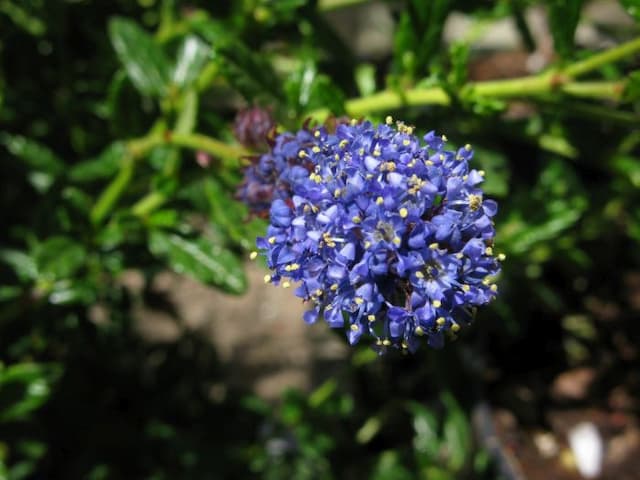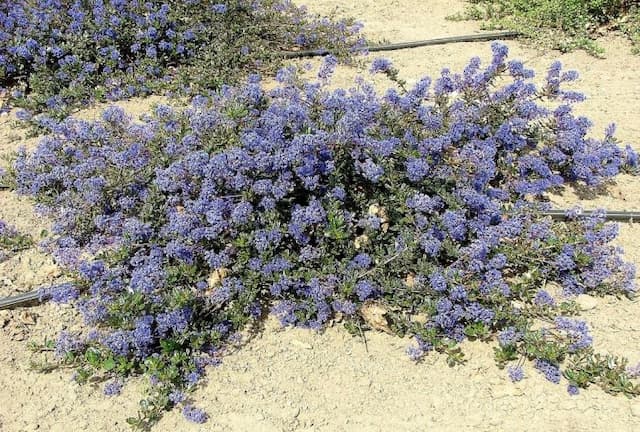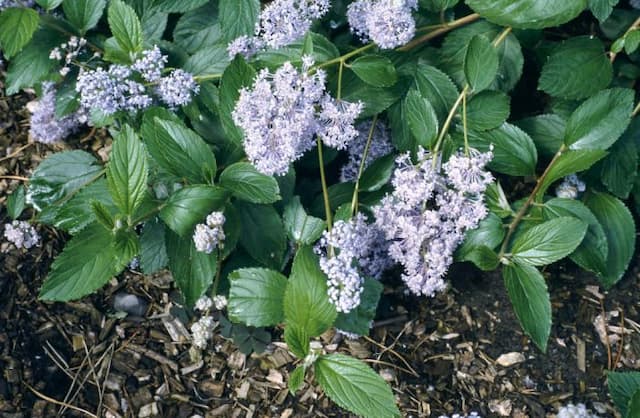California Lilac Ceanothus thyrsiflorus 'Mystery Blue'

ABOUT
The plant known commonly as 'Mystery Blue' is a visually striking cultivar with lush, deep green foliage. Its leaves are small and oval-shaped, presenting a dense and glossy appearance with a verdant, vibrant color that adds a luxurious texture to garden spaces. The real showstopper of 'Mystery Blue' is its blossoms. They are composed of numerous tiny, bright blue flowers densely packed into cone-shaped clusters. These clusters are arranged in a magnificent display of floral exuberance, creating a dramatic effect when the plant is in full bloom. The intensity of the blue can vary depending on factors like light exposure and soil type, but it typically presents as a rich, deep hue that's both enchanting and soothing to the eye. This dazzling floral display is often contrasted by the darker green of the leaves, making the blue stand out even more prominently. The plant's compact and bushy growth habit makes it an elegant addition to a variety of garden designs, providing both color and structure.
About this plant
 Names
NamesSynonyms
California Lilac, Blueblossom, Mystery Blue Ceanothus.
Common names
Ceanothus thyrsiflorus 'Mystery Blue'.
 Toxicity
ToxicityTo humans
The California lilac, which includes Ceanothus thyrsiflorus 'Mystery Blue', is generally not considered toxic to humans. There is little to no information suggesting that ingestion of parts of this plant by humans would result in poisoning. However, as with many plants, individual allergic reactions are possible, and it's generally advisable to avoid eating ornamental plants.
To pets
The California lilac is also not commonly listed as toxic to pets such as dogs and cats. However, ingestion of plant material may lead to gastrointestinal upset or an allergic reaction in some pets. Symptoms could include vomiting, diarrhea, or drooling if an animal were to eat a significant amount of the plant. As with humans, it is generally advisable to prevent pets from consuming non-food plants.
 Characteristics
CharacteristicsLife cycle
Perennials
Foliage type
Evergreen
Color of leaves
Green
Flower color
Blue
Height
6-12 feet (1.8-3.7 meters)
Spread
6-12 feet (1.8-3.7 meters)
Plant type
Shrub
Hardiness zones
7-10
Native area
California
Benefits
 General Benefits
General Benefits- Attracts Pollinators: 'Mystery Blue' is known to attract bees, butterflies, and other beneficial insects, contributing to pollination in the garden.
- Drought Tolerant: Once established, it requires minimal watering, making it suitable for xeriscaping and water-conservation landscapes.
- Fast Growing: This cultivar tends to grow quickly, providing a rapid cover and filling in garden spaces efficiently.
- Evergreen Foliage: Offers year-round greenery, providing a constant backdrop of foliage in garden settings.
- Low Maintenance: Requires limited pruning and upkeep, making it an ideal plant for low-maintenance gardens.
- Erosion Control: Its root system helps stabilize slopes and areas prone to erosion.
- Ornamental: Produces beautiful blue flowers that can enhance the aesthetic value of any garden.
- Deer Resistant: Generally resistant to browsing by deer, which is particularly beneficial in areas where deer predation is a problem.
- Habitat Friendly: Offers shelter and food to wildlife, supporting local ecosystems.
- Versatile: Suitable for a range of garden designs, from borders and hedges to stand-alone specimens.
 Medical Properties
Medical PropertiesThis plant is not used for medical purposes.
 Air-purifying Qualities
Air-purifying QualitiesThis plant is not specifically known for air purifying qualities.
 Other Uses
Other Uses- Wildlife Habitat: California lilac provides shelter and nesting sites for various birds and insects due to its dense foliage.
- Erosion Control: The robust root system of California lilac helps stabilize hillsides and slopes, thereby reducing soil erosion.
- Dye Production: Historically, some species of Ceanothus, including California lilac, were used by indigenous people to create a green dye from the leaves.
- Fragrance Sachets: Dried California lilac flowers can be placed in cloth sachets to add a fresh, floral scent to drawers and closets.
- Smudge Sticks: Leaves of California lilac can be dried and bound into smudge sticks, which are burnt for their aromatic properties.
- Garden Borders: Due to its compact growth habit, California lilac can be used to create attractive borders in landscaped gardens.
- Educational Tool: California lilac can be used in schools and botanical gardens to teach about native plant species and their ecological roles.
- Landscape Aesthetics: The vivid blue flowers of California lilac can be used to enhance the aesthetic of rain gardens and water-wise landscapes.
- Photography: California lilac's striking blue blooms are often a subject of interest for photographers capturing the beauty of spring flowers.
- Biomonitoring: California lilac is sometimes used in ecological studies as an indicator species to assess the health of a particular ecosystem.
Interesting Facts
 Feng Shui
Feng ShuiThe California Lilac is not used in Feng Shui practice.
 Zodiac Sign Compitability
Zodiac Sign CompitabilityThe California Lilac is not used in astrology practice.
 Plant Symbolism
Plant Symbolism- Resilience: Ceanothus, commonly known as Californian lilac, is native to North America and thrives in challenging conditions, symbolizing the ability to endure and prosper through adversity.
- National Pride: As a plant native to California, the Californian lilac often represents regional pride and the beauty of the local natural landscape.
- Renewal: The Californian lilac, with its vibrant blue flowers, symbolizes spring and the renewal that comes with the blooming season.
- Beauty: With its stunning blue flowers, the Californian lilac is a symbol of natural beauty and the aesthetic pleasures of life.
- Attraction: The blossoms of the Californian lilac are known to attract butterflies and bees, symbolizing allure and the power to attract others.
 Water
WaterThe California Lilac, or Ceanothus thyrsiflorus 'Mystery Blue', prefers dry conditions and should be watered infrequently once established. During the first growing season, water deeply once a week to help establish an extensive root system. After establishment, reduce frequency, only providing water during extended periods of drought. The ideal amount is roughly 1 gallon for smaller plants to 2 gallons for larger specimens every two to four weeks during the dry season. Be cautious not to over-water, as this plant is susceptible to root rot in poorly draining soils.
 Light
LightCalifornia Lilac thrives in full sun conditions where it can receive direct sunlight for at least six to eight hours a day. The best spot for it is in an area that gets full, unfiltered sunlight, as it will ensure the healthiest growth and maximize flower production. Partial shade is tolerable, especially in hotter climates, but flowering may be reduced.
 Temperature
TemperatureCalifornia Lilac is adaptable to various temperature conditions but prefers a Mediterranean climate. The plant can survive in temperatures as low as 10°F in winter and can tolerate summer highs well into the 90s°F. However, the ideal temperature range for the California Lilac is between 60°F and 70°F. These temperatures encourage the best growth and blooming potential.
 Pruning
PruningPrune California Lilac to maintain its shape and to remove any dead or diseased wood. It is best to prune right after the plant has finished blooming, usually in late spring or early summer, to avoid cutting off next year's buds. Occasional light pruning can help encourage bushier growth and more flowers. Deadheading is not necessary but can tidy up the plant if desired.
 Cleaning
CleaningAs needed
 Soil
SoilThe Blueblossom prefers well-draining, loamy or sandy soil, with a moderate to low fertility level and an ideal pH range between 5.5 and 7.5. A mix of garden soil, sand, and well-rotted compost can create an optimal environment. Regular mulching can help maintain soil moisture and health without requiring excessive water.
 Repotting
RepottingBlueblossoms typically do not require frequent repotting as they are mainly grown outdoors. When grown in containers, they should be repotted when rootbound, which is usually every 2-3 years to refresh the soil and provide room for growth.
 Humidity & Misting
Humidity & MistingBlueblossom plants, being drought-tolerant shrubs, need low to moderate humidity and are well-suited to the dry climate of their native California habitat. They thrive in outdoor conditions where the humidity mimics their natural environment.
 Suitable locations
Suitable locationsIndoor
Provide bright, indirect light and avoid overwatering.
Outdoor
Plant in full sun to light shade, well-draining soil.
Hardiness zone
7-10 USDA
 Life cycle
Life cycleCeanothus thyrsiflorus 'Mystery Blue', also known as California lilac, begins its life cycle as a seed which can remain dormant until conditions are optimal for germination, often requiring some form of stratification or disturbance to break dormancy. After germination, the seedling emerges and focuses on root establishment, followed by rapid vegetative growth where it develops its characteristic dense, dark green foliage. As the plant matures, it enters the flowering stage, unveiling clusters of vibrant blue flowers that attract various pollinators, usually in late spring or early summer. Following pollination, the California lilac produces small, hard seed capsules, which, when ripe, can burst open to disperse seeds for the next generation. This shrub may experience a period of dormancy during the colder months, depending on the climate. Over a period of several years, the Ceanothus thyrsiflorus 'Mystery Blue' reaches its full maturity, possibly living up to 20-25 years, after which it begins to senesce and eventually dies, completing its life cycle.
 Propogation
PropogationPropogation time
Spring to Summer
The most popular method of propagating Ceanothus thyrsiflorus 'Mystery Blue', commonly known as California Lilac, is through semi-hardwood cuttings. The ideal time to propagate California Lilac by cuttings is in the late summer when the new growth has started to mature and harden slightly. Cuttings should be taken from healthy, disease-free plants, selecting stems that are about 6 inches (approximately 15 centimeters) in length. The lower leaves of the cuttings are removed, and the base is dipped in rooting hormone before planting into a well-draining soil mix. The cuttings should be kept moist and in a warm environment with indirect light, where they will typically root within a few weeks. After roots have established, the new plants can be gradually acclimated to outdoor conditions and then transplanted to their final location in the garden.









